To make someone redundant, you must first establish that there’s a genuine redundancy situation, such as business closure, site closure, or a reduced need for certain work. Employers must consider a number of factors including the necessity, what alternatives have been considered or implemented, how many redundancies are needed, where they will come from, how people will be selected, and the timeline.
Many of these points may well be flexible and, as part of a proper consultation process, may be liable to change following discussion with employees. That said, it is still vital to start with some kind of plan of what you are trying to achieve and why. As employment lawyers, we will always want to see a client’s redundancy rationale as a first port of call to make sure their business case is robust, and to better understand what they are trying to achieve.
While an Employment Tribunal won’t look behind the decision to make redundancies or judge whether or not they were commercially sound (instead being concerned about the process, the consultation, the pooling, the selection criteria and the search for alternatives), having a sound business case is still important for your own planning requirements, as well as to explain the ‘why’ to your workforce. The latter will be crucial to avoiding disputes. It is highly advisable to seek support from an employment law specialist before embarking on any redundancy programme. Contact us at esphr for tailored, commercially-focused advice.

